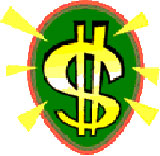|
 It is only appropriate that an Irish immigrant to the United States be the one credited with originating the dollar sign. Oliver Pollock sailed the high seas at the age of twenty-three, and settled in
Carlisle, Pennsylvania. This young entrepreneur rapidly established himself as a wealthy and
influentialWest Indies trader. It is only appropriate that an Irish immigrant to the United States be the one credited with originating the dollar sign. Oliver Pollock sailed the high seas at the age of twenty-three, and settled in
Carlisle, Pennsylvania. This young entrepreneur rapidly established himself as a wealthy and
influentialWest Indies trader.
Pollock moved his operation to Louisiana, where he amassed even more wealth as a trader, and as a
plantation owner. His success enabled him to provide supplies to the Patriots' cause in the Revolutionary War, and to maintain close contact and a degree of influence with Congress. Pollock's success allowed him easily to purchase military supplies to support "the cause," as the Spanish Empire had an
outpostin New Orleans, Louisiana. In his dealings with the Spaniards, Pollock used their currency, the
peso.
In true Spanish tradition, Pollock used an abbreviation for pesos, yet his
penmanshipmade the abbreviation appear to be the transposition of the letters "p" and "s."
Prior to 1775, the fledgling nations
monetary systemwas in disarray, and needed to be
revamped. By 1775, Congress decided to rectify the situation by backing all of its legal tender with the most commonly circulated coins that were, coincidentally, Spanish coins minted in the New World. Americans then began trading with "Spanish milled dollars," later termed "dollars," as Americans shed the "pounds" that were the
vestigesof British rule.
Congressman Robert Morris, to whom Pollock addressed his billing records, perpetuated the use of the dollar sign, and was the first high government official to give his blessing to the "s" with the two lines through it.
The appearance of the dollar sign in print, in a 1797 book by Chauncey Lee, signified the acceptance of the dollar as a purely American symbol.
|
|
note:
|
Carlisle: 卡莱尔
influential:有影响力的
plantation owner: 种植园主
outpost: 前哨
peso: 比索
penmanship: 书法
monetary system: 货币体系
revamp: 修补
vestige: 残余
|
|
